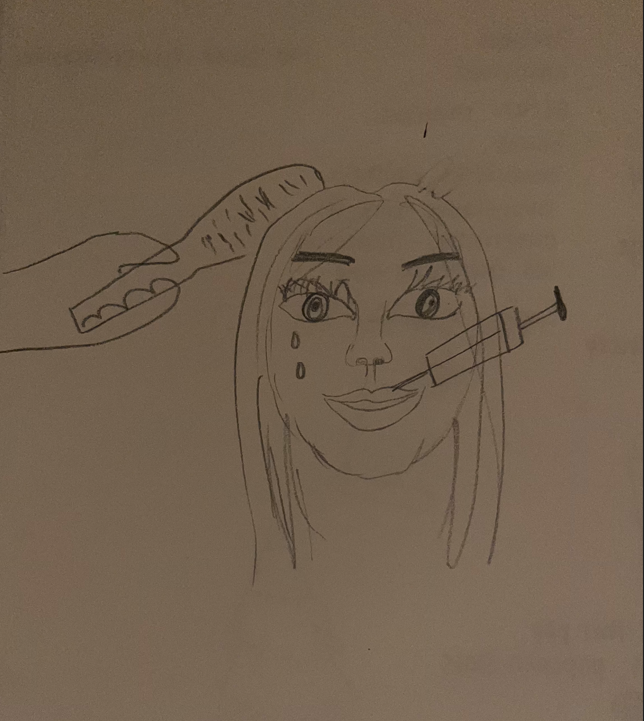“Beauty is Pain“
Bella Leiker

Overview
Project 3 sparked my curiosity and frustration, especially when I have been navigating unfamiliar territories like Photoshop and Figma. I had to not only explore these powerful design tools, but also find a creative visual metaphor to convey my intended message effectively.
I chose the metaphor, “beauty is pain,” which resonates with many women in this world today by suggesting that achieving or maintaining beauty often requires individuals to endure physical discomfort or make sacrifices. This metaphor highlights the idea that societal standards of beauty can sometimes demand individuals to go to great lengths, or even experience pain in the pursuit of this ideal. By underscoring the social and cultural pressures that can influence people’s perception of beauty, it suggests that people might feel compelled to engage in practices like dieting, cosmetic procedures, or uncomfortable clothing in order to meet the expectations of society or certain beauty ideals.
In some cases, people use this metaphor to convey that the process of self-expression and individuality can be challenging. I used Photoshop to create an almost perfect women who covers up her pain through smiling, while she has the lip injector which is causing her tears, conveying that looking beautiful quite literally causes pain. Using this metaphor can create empathy and understanding for those who go through tough times to conform to or challenge beauty norms. It’s important to note that “beauty is pain” is not a universal truth and doesn’t apply to every situation.
Beauty is a highly subjective concept, and different people have different perspectives on what is beautiful. Ultimately, the metaphor “beauty is pain” can be a powerful tool for discussing the societal pressures and sacrifices related to beauty, but it should also be used with sensitivity to the diverse range of perspectives and experiences related to beauty and self-expression. Navigating Photoshop and Figma to create a visual metaphor, not only expanded my skills but also allowed me to express my message in a unique and creative way.
What did you learn?
From my time working on this project, I learned that it takes a lot of brainstorming to come up with the perfect metaphor. I had to piece together various visual elements, text, and design principles to create an overall narrative for the metaphor I used. I spent days brainstorming, and my mind changed a lot. I reached the point where I had to ask my friends and family for ideas, because I wanted it to convey a message that meant something to me. I also learned how to use a lot more applications in Photoshop. Learning new software and creating complex visuals takes time and persistence, I cannot be afraid to experiment with new tools and design concepts. I am eager to play around with Photoshop more in the future.
What was easy?
Once the visual metaphor was decided, I turned to Figma for my lab, the lab helped to create patterns and ultimately run trial and errors, experimenting with layouts, colors, and images. This part of the journey was no less daunting, as I needed to create a cohesive design that worked out like it did in my head.
What was challenging?
The challenge was not just about using software, it was about finding the right metaphor that would serve as the foundation of my project’s design and message. The challenge for me was creating a visual metaphor that would tie all the project elements together. I spent hours brainstorming and sketching concepts until I found the perfect metaphor. I also had a very hard time finding licensed photos that were just right for the idea I had imagined in my head.
How could your submission be improved? How could the professor improve the assignment for the next class?
My submission could be improved by utilizing the wealth of resources available, such as tutorials, forums, and the DMA community support Professor Dunkle provides to enhance my skills and knowledge. If I had more time, I think I could have better performed the Photoshop tools by adding a pattern to the background. I had a heavy workload in my other classes during the time of this project, so I think I could have focused better if given more time to complete it. That is my only suggestion for the next class when they complete this assignment.
How might you apply your knowledge in future assignments or work scenarios?
It is absolutely crucial to have experience with Adobe apps like Photoshop and Illustrator to get a job in Marketing, so I feel like this brief introduction to these platforms was a good step forward. I currently have an internship which takes up a lot of my time, and there has been discussion of future use with Photoshop once I learn how to navigate it.
How did a specific reading or video inspire or help you?
“Making up Metaphors” by John Saito helped me to brainstorm a list of metaphor ideas that interested me, and it gave me a good push in the right direction. Megan’s blog and Madeline’s blog assisted in giving an example of a final project and blog post, giving me an idea of what to expect and relating to their feelings they had expressed throughout their project progression.

